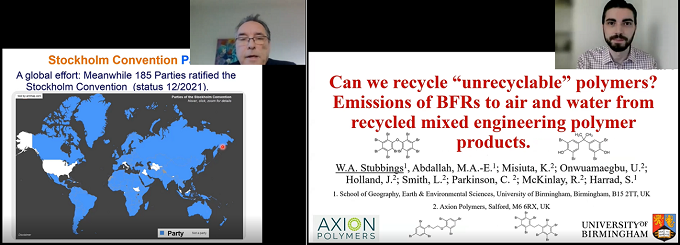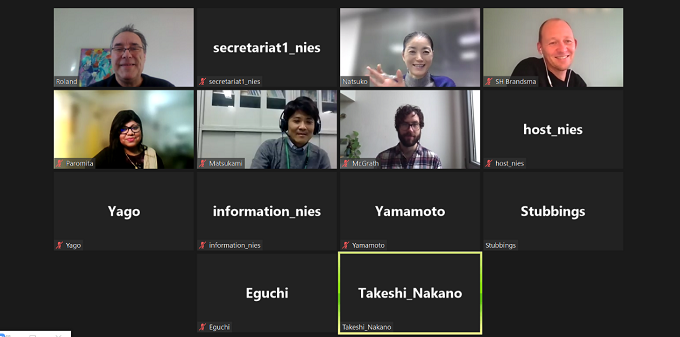Report of the NIES international seminar on the newly listed POPs in plastic waste and recycling streams
Report of the seminar
This online seminar was conducted as part of the research project entitled “Promotion of International Harmonization of Analytical Methods for Environmentally Sound Management of Plastic Wastes Containing Newly Listed POPs.” The project was formulated to meet national public administration needs to properly manage plastic products and waste containing POPs. The project has been jointly undertaken by NIES, Chiba University and IDEA Consultants, Inc., during the period from 2019 to 2021, with financial support of the Environmental Research and Technology Development Fund (JPMEERF20193001) of the Environmental Restoration and Conservation Agency of Japan.
As part of this project, the NIES research team has been conducting international inter-laboratory studies (ILSs) on POP analysis using plastic waste samples commonly available worldwide with the aim of promoting examination and standardization of such analytical methods. The ILS results are expected to contribute to solving technical problems in analyzing POPs and to be used to introduce these new analytical methods to emerging and developing countries. The NIES team has also been investigating treatment and recycling status of the products containing plastic additive POPs.
In this seminar, the NIES researchers presented the research outcomes from the above-mentioned project. Researchers from other institutions in Belgium, Germany, India, the Netherlands, and the United Kingdom also shared their latest research findings on BFRs and CPs in waste and recycling streams.
The seminar consisted of three sessions: the first session on BFRs with three presentations, the second session on CPs with another three presentations, and the last session for open discussion. The first session on BFRs covered topics such as behaviors of POPs in waste electrical and electronic equipment (WEEE) recycling and introduction of survey results on alternative BFRs. The second session covered the latest information and research findings on detailed analytical methods and issues on CPs, including short-chain CPs that are already listed as POPs in the Stockholm Convention; medium-chain CPs that are POP candidates; and long-chain CPs whose production has been increasing in recent years. The latest information on the actual content of CPs in plastic products in the Japanese and European markets was also shared among the participants.
In the last session, the participants actively discussed the issues and future research needs of each country related to management of plastic waste containing POPs. A mutual understanding was established among the participants on the following topics: unintentional contamination by POPs associated with circular use of end-of-life plastics; evaluation of alternative BFRs; needs for investigating actual state of POP contamination in developing countries; and analytical issues for newly identified chemical substances of concern. At the end of the seminar, the participants confirmed their continued collaboration to enhance proper management of plastic waste containing POPs, and to strengthen technical support to countries whose POP analysis technology infrastructure is still weak.
Based on the valuable discussion during this seminar, the NIES research team has renewed its commitment to promoting proper management of waste containing POPs as well as responding to the technical needs of other countries to achieve both sustainable use of plastic resources and effective management of hazardous chemical substances.


Contacts
National Institute for Environmental Studies
Material Cycles Division
Material Cycles Assessment Research Section
Natsuko Kajiwara, Chief Senior Researcher
International Waste Management Research Administration Office
Tomonori Ishigaki, Manager
Risako Nogami, Officer
Kae Inaba, Expert
For more information
Brandsma S.H., Brits M., Groenewoud Q.R., van Velzen M.J.M., Leonards P.E.G., de Boer J. (2019) Chlorinated paraffins in car tires recycled to rubber granulates and playground tiles. Environmental Science & Technology 53, 7595–7603
Brandsma S.H., Brits M., de Boer J., Leonards P.E.G. (2021) Chlorinated paraffins and tris (1-chloro-2-propyl) phosphate in spray polyurethane foams – A source for indoor exposure? Journal of Hazardous Materials 416, 125758
Eguchi A., Matsukami H., Takahashi A., Kajiwara N. (2021) Simultaneous determination of polybrominated diphenyl ethers and hexabromocyclododecane in plastic waste by short-column gas-chromatography-quadrupole mass spectrometry and electron capture detector. Chemosphere 277, 130301
Kajiwara N., Matsukami H., Malarvannan G., Chakraborty P., Covaci A., Takigami H. Recycling plastics containing decabromodiphenyl ether into new consumer products including children’s toys purchased in Japan and seventeen other countries. Chemosphere 289, 133179
Matsukami H., Takemori H., Takasuga T., Kuramochi H., Kajiwara N. (2020) Liquid chromatography-electrospray ionization-tandem mass spectrometry for the determination of short-chain chlorinated paraffins in mixed plastic wastes. Chemosphere 244, 125531
McGrath T.J., Poma G., Matsukami H., Malarvannan G., Kajiwara N., Covaci A. (2021) Short- and medium-chain chlorinated paraffins in polyvinylchloride and rubber consumer products and toys purchased on the Belgian market. International Journal of Environmental
Research and Public Health 18, 1069
Stubbings W.A., Abdallah M.A.-E., Misiuta K., Onwuamaegbu U., Holland J., Smith L., Parkinson C., McKinlay R., Harrad S. (2021) Assessment of brominated flame retardants in a small mixed waste electronic and electrical equipment (WEEE) plastic recycling stream in the UK. Science of The Total Environment 780, 146543
Yago G., Capella R., Kajiwara N., Babayemi J.O., Torres, J.P.M., Weber R. (2022) Inventory approach for short-chain chlorinated paraffins for the Stockholm Convention implementation in Brazil. Chemosphere 287, 132344
- What's New
- What's New 2025
- What's New 2024
- What's New 2023
- What's New 2022
- What's New 2021
- What's New 2020
- What's New 2019
- What's New 2018
- What's New 2017
- What's New 2016
- What's New 2015
- What's New 2014
- What's New 2013
- What's New 2012
- What's New 2011
- What's New 2010
- What's New 2009
- What's New 2008
- What's New 2007
- What's New 2006
- What's New 2005
- What's New 2004
- What's New 2003
- What's New 2002
- Event Information
- Visit NIES